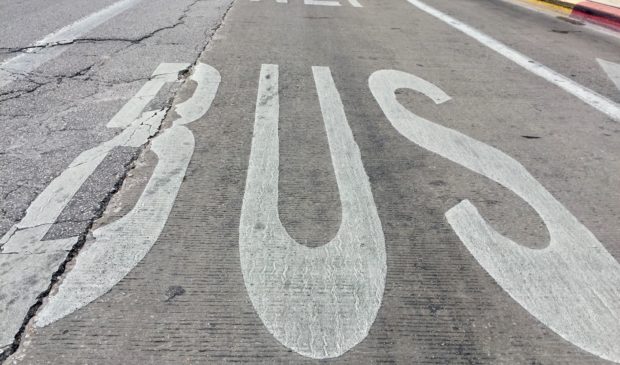Final Guadalupe plan hits the streets
Tuesday, December 5, 2017 by
Caleb Pritchard At long last, the city’s shortest corridor has its plan.
The Austin Transportation Department today released the much-anticipated Guadalupe Corridor Plan, a 66-page document that calls for a multimodal revolution along the Drag.
As expected, the document recommends the conversion of two car lanes into bus-only lanes on Guadalupe Street between 29th Street and Martin Luther King Jr. Boulevard. And to make room for an expanded sidewalk and a protected bike lane on the east side of the roadway, all on-street parking on the west side could be removed.
City Council launched the planning effort in 2013, funding it with bond money approved by voters the year before. ATD staff produced a glimpse of the preferred scenario in May 2016 and teased the publication of the full report by January. However, that work was delayed when voters approved the 2016 mobility bond that November. The department pivoted to focus on laying the groundwork to deliver the bond’s $720 million worth of projects in the eight-year timeline promised by Council.
The recommendations in the Guadalupe Corridor Plan – which total $33.7 million – are being reviewed by the Corridor Program Office as it assembles its $482 million set of projects to be funded by the 2016 bond. Not every piece of the plan is guaranteed to make the cut, which means that its vision could still be years away from being realized.
Aside from bond money, however, the plan suggests additional funding could come through the creation of a tax-increment financing district or from state and federal benefactors.
“(F)ederal agencies have looked much more favorably on transportation projects that have significant private sector involvement and where the benefits are not focused solely on the provisions for automobile traffic, but rather examine multimodalism and the relationship between redevelopment initiatives and a reinvented roadway,” the plan states.
Indeed, the plan’s focus is broadened beyond just car traffic. The bus-only lanes would give the Capital Metropolitan Transportation Authority’s 20 routes that operate along the corridor exclusive right of way for an entire mile, extending the existing transit priority lanes in downtown. By reducing car throughput, the roadway would theoretically increase its people throughput.
“Based on an analysis from CapMetro, transit only lanes through this corridor ‘will save CapMetro buses up to 3 minutes in travel time’ and ‘time savings alone will attract 218,000 new riders annually,’” the plan states.
To accommodate for the loss of car space, the plan recommends converting Nueces Street north of 25th Street into a two-way to handle local traffic through West Campus. It also calls for a stoplight at the three-way intersection of Nueces and Guadalupe streets.
West 24th Street from Guadalupe to North Lamar Boulevard would switch to three lanes: one travel lane in each direction with a turn lane in between. A protected bike lane would be installed on the eastbound side, while cyclists traveling westbound would be given a sharrow.
The document also calls for more trees along Guadalupe Street as well as bulb-outs to shorten the distance between crosswalks.
Left unmentioned in the plan, however, is Project Connect, the high-capacity transit planning process Capital Metro is currently engaged in. The initiative has identified Guadalupe Street as a potential investment corridor for a possible light rail or bus rapid transit line. The ideal forms of both of those modes would involve center-running lanes that allow the vehicles to avoid conflicts with right-turning cars ahead of them.
The Corridor Program Office is expected to send its draft corridor implementation plan to Council by early March. Project Connect will produce a menu of its preferred projects in April.
The Austin Monitor’s work is made possible by donations from the community. Though our reporting covers donors from time to time, we are careful to keep business and editorial efforts separate while maintaining transparency. A complete list of donors is available here, and our code of ethics is explained here.
You're a community leader
And we’re honored you look to us for serious, in-depth news. You know a strong community needs local and dedicated watchdog reporting. We’re here for you and that won’t change. Now will you take the powerful next step and support our nonprofit news organization?









